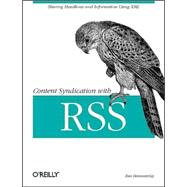
Ben Hammersley is an English emigre, living in Sweden, with his wife, three greyhounds, a few hundred deer, and a two-way satellite connection. For a day job, he writes for the British national press, appearing in The Times, The Guardian, and The Observer, but in his free time, he blogs excessively at www.benhammersley.com and runs the Lazyweb.org ideas site. As a member of the RSS 1.0 Working Group, he survived the Great Fork Summer, and as a journalist he has been accosted by the secret police of two countries. To this day, he doesn't know which was worse.
| Preface | ix | ||||
|
1 | (9) | |||
|
1 | (1) | |||
|
1 | (7) | |||
|
8 | (1) | |||
|
8 | (2) | |||
|
10 | (6) | |||
|
10 | (2) | |||
|
12 | (1) | |||
|
12 | (2) | |||
|
14 | (2) | |||
|
16 | (10) | |||
|
16 | (2) | |||
|
18 | (3) | |||
|
21 | (2) | |||
|
23 | (3) | |||
|
26 | (16) | |||
|
26 | (5) | |||
|
31 | (2) | |||
|
33 | (6) | |||
|
39 | (3) | |||
|
42 | (13) | |||
|
42 | (5) | |||
|
47 | (3) | |||
|
50 | (5) | |||
|
55 | (17) | |||
|
57 | (3) | |||
|
60 | (4) | |||
|
64 | (8) | |||
|
72 | (38) | |||
|
72 | (38) | |||
|
110 | (7) | |||
|
110 | (4) | |||
|
114 | (1) | |||
|
115 | (2) | |||
|
117 | (15) | |||
|
117 | (7) | |||
|
124 | (8) | |||
|
132 | (17) | |||
|
132 | (8) | |||
|
140 | (4) | |||
|
144 | (5) | |||
|
149 | (12) | |||
|
149 | (1) | |||
|
150 | (5) | |||
|
155 | (1) | |||
|
156 | (5) | |||
|
161 | (18) | |||
|
161 | (3) | |||
|
164 | (2) | |||
|
166 | (13) | |||
| A. The XML You Need for RSS | 179 | (11) | |||
| B. Useful Sites and Software | 190 | (5) | |||
| Index | 195 |
The New copy of this book will include any supplemental materials advertised. Please check the title of the book to determine if it should include any access cards, study guides, lab manuals, CDs, etc.
The Used, Rental and eBook copies of this book are not guaranteed to include any supplemental materials. Typically, only the book itself is included. This is true even if the title states it includes any access cards, study guides, lab manuals, CDs, etc.